 This time last year, in 2014, I visited the city of Shaoxing, exhibiting my Canadian quilts and bags alongside those of quilters from China, Taiwan, Japan, USA, Korea, and Australia. You can read about my first adventure to China here.
This time last year, in 2014, I visited the city of Shaoxing, exhibiting my Canadian quilts and bags alongside those of quilters from China, Taiwan, Japan, USA, Korea, and Australia. You can read about my first adventure to China here.
This year, in early October 2015, I returned to China once again, and again I was asked to bring quilts and bags to display. My husband and I stuffed as many quilts and bags as would fit in our suitcases for display during Keqiao Fashion Week, which coincided with the China Keqiao Textile Expo.
I was expected to teach 3 day-long classes in quilting techniques, and give at speech at the plenary session. This time I knew better what to expect, so there were fewer outright surprises; however, the scale of China’s population, history and culture will never fail to astonish me.

The Display
My booth this year was spacious and airy. But I had crammed so many quilts and bags into every available nook and cranny in our luggage that we still required an extra wall for all that I had brought along to show.
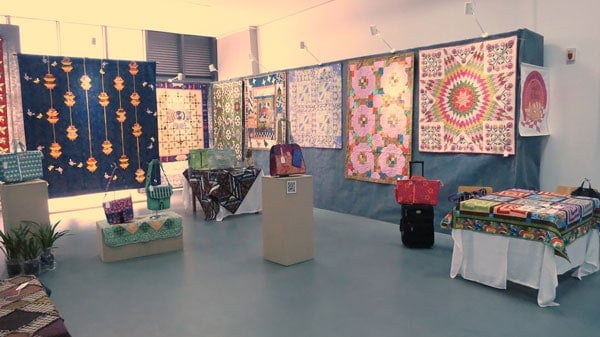
I had also brought along a little hand-quilting in case I had a chance to demonstrate at the booth. But things were so busy with the classes, there wasn’t much chance to show this skill.
This year, the quilting exhibit was not located in the same building as the main expo.

China International Quilting Creative Design Competition took place in a geodesic dome stadium next door. This gave the quilts the respect they deserved, but made the display less well attended by the public as a result.
In addition to my classes, there were also classes taught by Japanese teachers; they also brought quilts, but because there were only the two of us from overseas represented, this year had less of an international flavour. Instead, modern quilting from mostly local Chinese artists was given prominence.
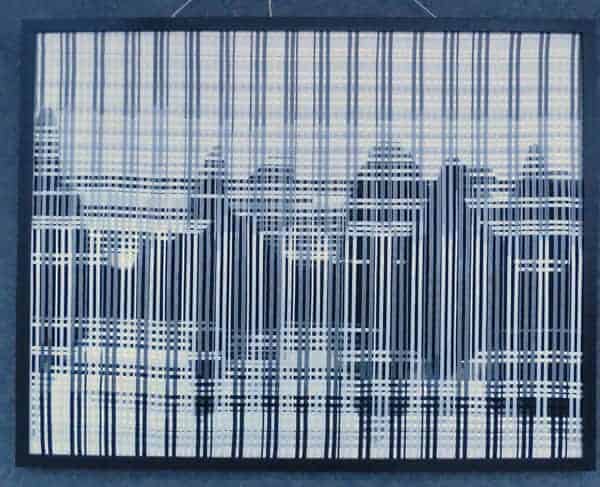
This was not a juried show, as we know them, but it was a competition. Originally I was asked to participate in the judging, but I was exhausted after our 14 hour flight and a full day of setting up my quilts. Because I was jet-lagged, and because the judging had not yet begun by 9 pm, I begged off to get a few hours sleep prior to teaching my first class the following morning. I was later told that the judging process began after I left, and went on until midnight.
A Range of Eclectic Work
To be honest, I would have had difficulty in judging the many pieces on display. The range of work was eclectic.

There were wall hangings, and three dimensional art; representative scenes in fabric, as well as colourful patterns. There were hand-sewn pieces and machine pieced patchwork. It was all displayed together, and in the midst of it all there were representative pieces of some very old Chinese quilts. How do you compare apples and oranges?
While there were a few pieces I saw that were particularly striking, I would agree with many of the speakers at the later conference session that modern quilting in China (as exhibited in Shaoxing this year) has not yet reached international standards for artistic expression.But who determines these so-called international standards of artistic expression? Truth be told, this is not really what I am about. I love to explore the many techniques of quilting, and I strive to be technically proficient in my own work. As a teacher and designer of quilts and bags, I love it when others “get it” with my work as a catalyst. You can see the spark ignite a new fire: they run with it, they make it their own, they use my designs as a scaffolding for their own self expression. If someone takes care with what they are making, and they are pleased with the result, I applaud this — even if the finished quilt might violate my own colour sense, or my own technical standards. Who am I to judge? Still, I believe everyone innately knows and appreciates quality, and I have no doubt that with the interest shown in quilting by many dedicated practitioners in China, the standards of quilting design and creativity there will soon rival that of the best in the world.
Teaching Classes is an Interesting Experience in China
 At the request of Yang Tie Gang, a local businessman with a deep interest in promoting quilting in China, I was asked to teach three day-long classes to about 26 students. Mr. Yang organized the event, and through him I requested that each student have available to them scissors, matching thread, pins and other basic sewing supplies, along with kits including the fabric and batting required and a minimum of 1 sewing machines for every 2 students. Last year’s experience taught me that most students merely turned up with willing hearts and hands.
At the request of Yang Tie Gang, a local businessman with a deep interest in promoting quilting in China, I was asked to teach three day-long classes to about 26 students. Mr. Yang organized the event, and through him I requested that each student have available to them scissors, matching thread, pins and other basic sewing supplies, along with kits including the fabric and batting required and a minimum of 1 sewing machines for every 2 students. Last year’s experience taught me that most students merely turned up with willing hearts and hands.
 I had learned from the previous year’s shortages, and was very specific about what I needed to run each class. But you don’t always get what you ask for. For example, in addition to the basic supplies, I had also asked for 4 cutting mats, rotary cutters and rulers. When we ran short, it necessitated using the few supplies I had brought along. I especially missed having rotary cutting supplies, except for one very small mat that was supplied. After 3 days of classes, this mat was so well used, I could poke my thumbs through it.
I had learned from the previous year’s shortages, and was very specific about what I needed to run each class. But you don’t always get what you ask for. For example, in addition to the basic supplies, I had also asked for 4 cutting mats, rotary cutters and rulers. When we ran short, it necessitated using the few supplies I had brought along. I especially missed having rotary cutting supplies, except for one very small mat that was supplied. After 3 days of classes, this mat was so well used, I could poke my thumbs through it.
I learned that most of my students were in fact art teachers. Quilting is part of the art curriculum in the local schools. Sewing machines for my classes were supplied by a local Singer Sewing Machine distributor. She gave the class a brief instruction in the use of the machines at the beginning of the class, and then it was up to me — and my extremely capable interpreter Julia, to provide instruction in quilting techniques. I had prepared a class for a modern wall hanging, a small bag, and a double-sided table runner. With the techniques of paper piecing, reversible quilt-as-you-go, and three-dimensional thinking, I knew my students could take these techniques and ideas back to their own pupils.
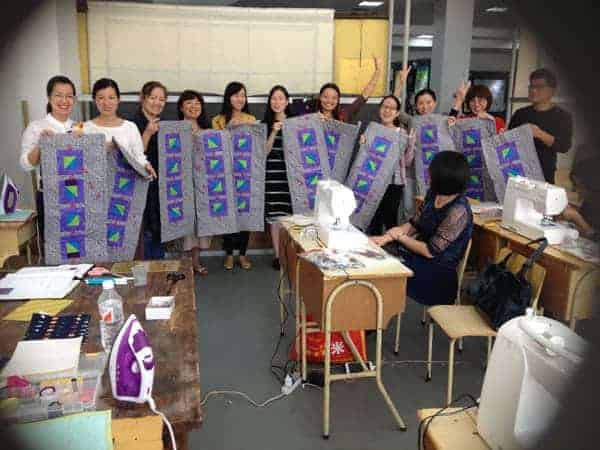
Once again I was impressed with how able my eager students were. With a quick demonstration, and Julia’s instruction, they caught on to what was required and got it done efficiently and with style.
At the end of my last class, I took a quick poll of those present and asked how many had a sewing machine. Not one of them had one of their own. Each school that they taught at had at least one sewing machine. However, I also asked them how many had used a sewing machine before, and I was astonished to learn that none of them had.

The speed with which they picked up the skill impressed me. I gently suggested that if they wished to pursue quilting as a hobby and art form, they would need to get their own sewing machine, and I pointed them toward the Singer Sewing Machine booth. I was happy to see some of them approaching the dealer after the classes.
An Interview with the Quilting Association
With my translator Julia’s help, I spent a little time being interviewed by the Chairwoman of the Zhejiang Quilting Association, of which I am an honorary member. Mai Sou Qiu was interested in my reaction to the quilt show and was curious about quilting in North America.
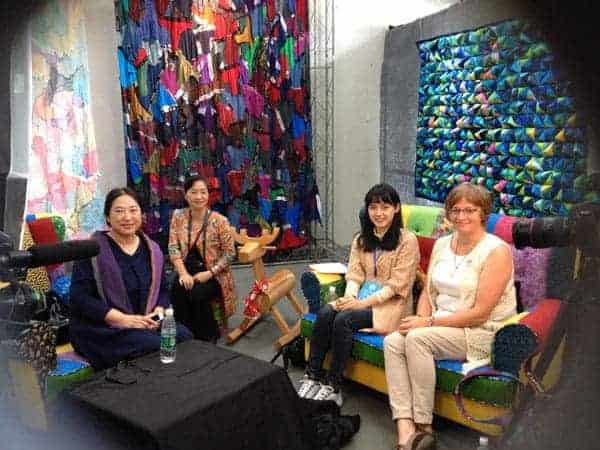
There are few if any quilting shops in China like what we are used to in the west; and I think my description of our multitude of guilds, shows and shops seemed rather fanciful to her. I could see the incredulity on her face when she learned that some of my designer friends even teach courses on ships, combining travel, sight-seeing and quilting. I hope that one day Ms. Mai will take me up on my invitation to visit in person and see what quilting is like in Canada.
Imagine having a television camera pointed at you while you are asked questions about quilting in your native country. For one brief moment, I was representative of all quilters in Canada, for China. If I had stopped to think about it, I suppose I would have trembled at the responsibility. But like most things I tackle, I just ploughed straight on, full steam ahead. It is only upon reflection that I stop and wonder how I came to be placed in this position. How can any one person even give an adequate account of the many diverse quilting styles and themes across a country as diverse as Canada? I hope I presented Canadian quilting at its best, but the experience of being interviewed as a representative of it is very humbling indeed.
A Speech at the First China International Quilt Academic Seminar

The last day of the show I gave a speech at the First China International Quilt Academic Seminar. It was a full day of lectures from academics from China, including Dai Hua Quin, Professor of the Academy of Arts and Design for Tsinghau University in Bejing, Yasuko Saito, Chiarwoman of the Japanese Modern Quilt Association, Yi Wang, Professor of the Beijing Institute of Fashion Technology, Professor Marin Hanson Curator of the International Quilt Study Center and Museum at the University of Nebraska – Lincoln, Xue Zhi Wu, Chairman of the National Quilt Art Salon, Yue Lv Professor of the School of Design for the Central Academy of Fine Arts, Li Ma from the Research Institute of Guizhou Province who studies traditional work, Xiao Hong Zie from the Shandong Vocational College of Light Industry, Xue Sheng Cao, Assistant of the Studio of China Craft and Art Masters, Xiao Zeng, Editor for the Jieli Publishing House, Yan Hu From the College of Artistic Design, Shao Ling Zhan, Director of Siyuetang Handmade House in Nanjiing, and Ping Qian from Ningbo Dahongying University.
Fortunately, my interpreter Julia not only translated my talk but also filled me in on what everyone else was discussing. I was very moved to learn from Yi Wang of the traditional needlework of the Chinese ethnic minorities, and was given the opportunity to examine firsthand some of the intricate folding techniques and stitchery used for ceremonial clothing. The workmanship of the natives from south China was exquisite.
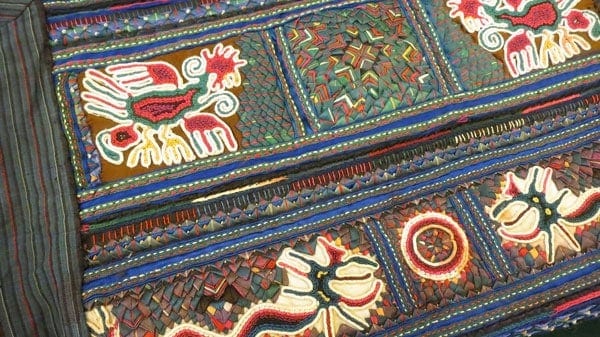
A Strikingly Different Perspective
Other talks discussed the need for environmentally friendly textiles, the proper use of colour, the need to find the root of Chinese quilting and the protection of traditional Chinese quilting, the use of fashion as art, teaching quilting in the school system, recycling for modern quilts, storytelling with quilts etc. One topic that did not seem to come up was the possibility that quilting could catch on in China among the common people.
Quilting seems to be regarded as more of an academic, elitist pursuit in China while here at home it is available to anybody with an interest. It is ironic that the most striking work I saw during the show were the pieces of traditional quilting done in the past by common people. I may have been the least credentialed person in the room, but I insisted that to promote quilting in China, it must take root first among the people. In my own talk, I tried my best to impart how this was accomplished historically within Canada, and I even suggested how it might yet happen in China.
A high cultural aesthetic can develop anywhere but I think it has to start with a sense of playfulness. Keep it fun, and it will be beautiful.
Creativity and Joy
I brought a few packages of charm squares to give away as gifts to some of the many people who like me, had come so far to this international event — people like Dai Hua Quin from Beijing, and Yasuko Saito from Tokyo.
But I was happy that I had some left over to give to a tiny Chinese woman who swept the floors of the geodesic dome stadium. She had been most attentive in the background as Julia translated each of my classes, and watched as my students hunkered down over their tasks.
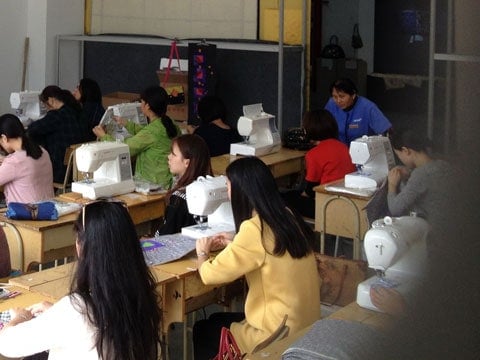
She was never in the way, but always in the background, taking it all in. She’s the one in blue smock near the top right of this picture. She was overjoyed that she had been given this tiny gift, and hugged me many times.
You just never know what is in the heart of a person, or from where something amazing, beautiful, or insightful might creatively spring forth. I feel privileged to be given the chance to nurture that in others.
Sightseeing With A Friend: Shaoxing, Yiwu Market, and Xiang Lu Mountain
When the work was all over, and the quilts were once again packed up into our many suitcases, we had a couple of days to do a bit of sightseeing in the area of Shaoxing. During our 2014 visit, we became friends with our interpreter Jenny, and we stayed in touch from afar even after she married and moved to another business.
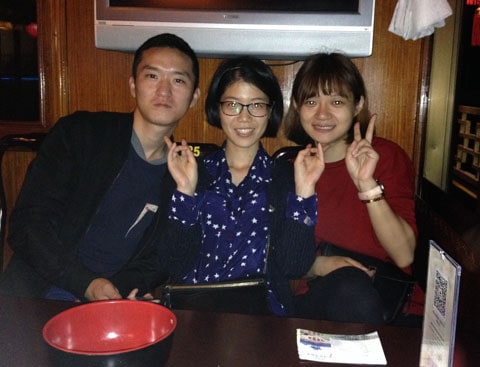
On this return visit, we were fortunate to reconnect with Jenny, her husband Hai Zin, and her friend Kennan. Our hosts generally took us to Buddhist restaurants, where our vegan needs could be met without anxiety — Buddhists are vegetarian. We did go once to a traditional regional restaurant that had a buffet. A Chinese restaurant is organized somewhat differently than we would expect here in the west. As you enter the front door, you find a display of what is available: along one wall, in writhing tanks, tubs and baskets, are any number of live animals that can be eaten — fish, crabs, eels, shrimp, turtles and even some rather large live snakes.
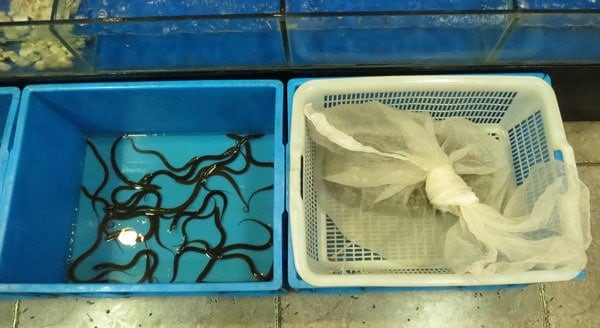
We paid closer attention to the other wall, where a large selection of veggies were lined up in baskets. You select the veggies and entrust that the chef will combine them in ways to please your palate.
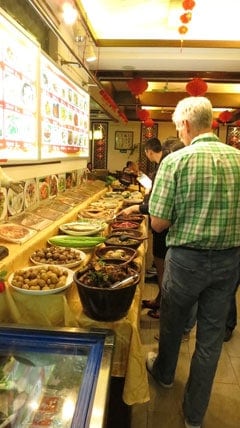
When it shows up on the huge lazy susan in the middle of the table, everyone digs in with their chopsticks. Or in my case with my plastic fork. I’m all thumbs with chopsticks.
Yiwu Market
We spent a day of travel to Yiwu City to try to navigate the vast Yiwu Market. It was my hope to make a contact here for suppliers of hardware and zippers for the many bags I design. Without Jenny by my side, I never would have been able to navigate this immense commodities market. The size of the place dwarfs any expectation you might have of it. I think I found what we were looking for, but after spending hours looking for and checking out the quality of the merchandise, we realized that we had not seen 1/10,000th of the place. Whether or not I have found a supplier for what I need remains to be seen.
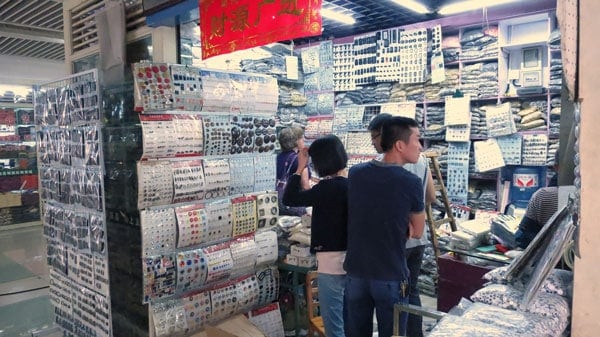
Earlier in Shaoxing I had tried to do a bit of shopping on my own for my mother back home, and was rather discouraged when I entered a busy underground store and could not find the exit. Eventually I begged the girl at the entrance to let me out against the flow of shoppers pouring in. I think she took pity on me, and allowed me to go back out the way I came in.
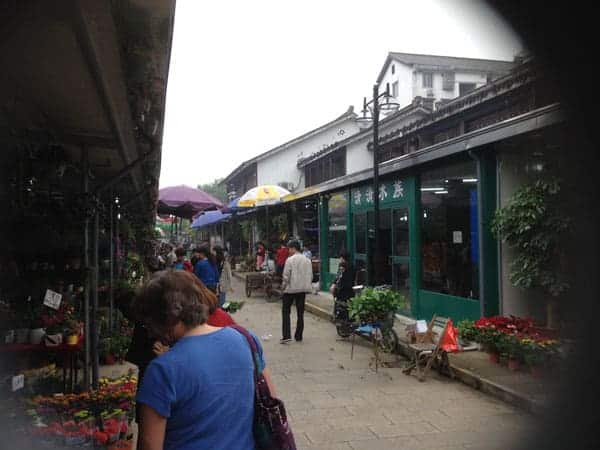
On the very last day Jenny’s friend Kennan uber’d us around Shaoxing to visit various parks and an Old Market.
Xiang Lu Mountain
A highlight of our day with Kennan took us to the top of Xiang Lu Mountain, where the Lufeng Buddhist Temple is found. Scholars debate how the peak came to be named after an incense burner, but we saw it rising in brume, so it seems apropos.

Although the place has a very long history (dating from around 2150 BCE, when Yu the Great brought flood control to Kuaiji — the area now known as Shaoxing — and started the Xia Dynasty), the temple itself was rebuilt in 1990, so the facilities are quite modern. There are several religious buildings, one after the next, on one’s way to the summit, and the monastery is home to several dozen working Buddhist monks.
It was a humid 30 degrees C the morning we climbed the steep stone steps some 354 metres to the top. This is not as high as the CN tower, but there are more stairs overall, as the path runs up through the foothills until reaching the base of the summit proper. I had to take frequent rests and was humbled to see a group of 70 year old women coming down in a spritely fashion as I was trudging up. They started well before 7 am to make their pilgrimage to the summit. May their devotion always be rewarded by good health!

Kennan herself makes the pilgrimage several times a year, and she was able to interpret for us and give us a hint of the significance of the various sacred writings that have been carved into the rock walls. At the top there was a group studying Buddhist scripture, shrines for prayer and offerings, and a large furnace where paper offerings were being burned.
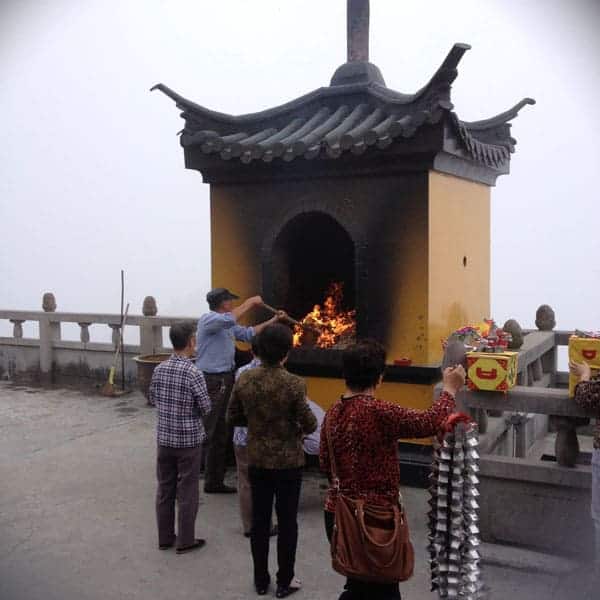
We were very fortunate to discover, when we reached the top, that a wealthy patron had donated a free noodle soup lunch to all pilgrims who decided to make the journey up the mountain that day. Simple and delicious, it was gratefully received and really hit the spot.
Back to Shaoxing
The last night we took a tour by riverboat around the old city of Shaoxing.

Seeing it from the water, as it must have been traveled in ancient times, gave us an entirely new perspective on this thoroughly modern city. At night, the air is clear, it is brightly lit and very pretty indeed.Thanks to our splendid guides and translators, our trip will always be fondly remembered.
And Finally Home Again
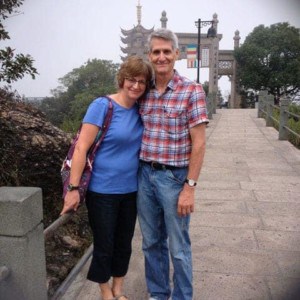 And so we flew home, with our suitcases filled with quilts, to try to make sense of our busy 11 days in China, while dealing with jetlag.
And so we flew home, with our suitcases filled with quilts, to try to make sense of our busy 11 days in China, while dealing with jetlag.
“Have a sleep; then you’ll be all right,” said his mother. Obediently, Little Shuan coughed himself to sleep. The woman waited till his breathing was regular, then covered him lightly with a much patched quilt.
– From Medicine, by Lu Xun ca. 1918, Shaoxing-born internationally revered Chinese author
Leave a Reply